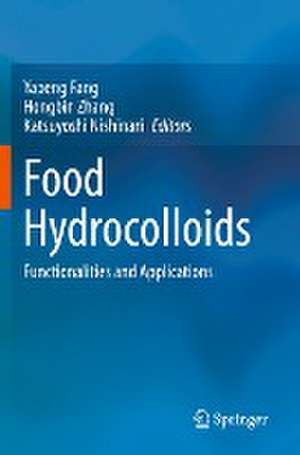Food Hydrocolloids: Functionalities and Applications
Editat de Yapeng Fang, Hongbin Zhang, Katsuyoshi Nishinarien Limba Engleză Paperback – 19 mai 2022
The book introduces the definition, classification, source and structure of hydrocolloids and provides a comprehensive description of their functionalities and food-related applications. The emphasis is put on the basic concepts and mechanisms underlying functionalities, and the new developments in fundamental knowledge and practice. The book would be useful for students or professionals working in the fields of food science & technology, and biopolymers etc. It would help to organize hydrocolloids knowledge in a more systematic framework and enlighten further profound investigations.
| Toate formatele și edițiile | Preț | Express |
|---|---|---|
| Paperback (1) | 792.51 lei 6-8 săpt. | |
| Springer Nature Singapore – 19 mai 2022 | 792.51 lei 6-8 săpt. | |
| Hardback (1) | 966.87 lei 3-5 săpt. | |
| Springer Nature Singapore – 19 mai 2021 | 966.87 lei 3-5 săpt. |
Preț: 792.51 lei
Preț vechi: 966.47 lei
-18% Nou
Puncte Express: 1189
Preț estimativ în valută:
151.67€ • 157.76$ • 125.21£
151.67€ • 157.76$ • 125.21£
Carte tipărită la comandă
Livrare economică 14-28 aprilie
Preluare comenzi: 021 569.72.76
Specificații
ISBN-13: 9789811603228
ISBN-10: 9811603227
Ilustrații: XI, 524 p. 149 illus., 90 illus. in color.
Dimensiuni: 155 x 235 mm
Greutate: 0.74 kg
Ediția:1st ed. 2021
Editura: Springer Nature Singapore
Colecția Springer
Locul publicării:Singapore, Singapore
ISBN-10: 9811603227
Ilustrații: XI, 524 p. 149 illus., 90 illus. in color.
Dimensiuni: 155 x 235 mm
Greutate: 0.74 kg
Ediția:1st ed. 2021
Editura: Springer Nature Singapore
Colecția Springer
Locul publicării:Singapore, Singapore
Cuprins
Chapter 1. Introduction to food hydrocolloids.- Chapter 2. Solution properties.- Chapter 3. Rheological and thickening properties.- Chapter 4. Gelling properties.- Chapter 5. Emulsifying properties.- Chapter 6.Liquid Foaming Properties .- Chapter 7. Tribological and sensory properties.- Chapter 8. Coating and film-forming properties.- Chapter 9. Self-assembling properties.- Chapter 10. Flavour delivery.- Chapter 11. Encapsulation and targeted release.- Chapter 12. Replacement of fat or starch.- Chapter 13. Structuring for elderly foods.- Chapter 14. Bioactivities.- Chapter 15. Dietary Fibers: Structural Aspects and Nutritional Implications.
Notă biografică
Yapeng Fang is a Distinguished Professor at the School of Agriculture and Biology, Shanghai Jiao Tong University. He holds a bachelor and master degree in polymer physics and chemistry from Shanghai Jiao Tong University, and a PhD degree in Food Science and Health from Osaka City University. His research interest is focused on the structure-function relationship of hydrocolloids, and the design of future foods based on hydrocolloid technologies. He currently serves as an Associate Editor of the journal Food Hydrocolloids.
Hongbin Zhang is a full professor with tenure at the Department of Polymer Science and Engineering, School of Chemistry and Chemical Engineering, Shanghai Jiao Tong University (SJTU). He holds his master degree in applied chemistry and PhD in polymer materials from SJTU. His research interest is focused on the interdiscipline of polymer physicochemistry, rheology, colloid chemistry, and food science, involving polysaccharides, solutions, emulsions, and hydrogels.
Katsuyoshi Nishinari is now a specially appointed professor at Glyn O. Phillips Hydrocolloids Research Centre, Hubei University of Technology. He worked for National Food Research Institute and then Osaka City University (OCU), and is an emeritus professor of OCU. He is also visiting professors at Glyndwr, ESPCI, SJTU, Osaka, Keio, and other universities. His research interest includes food hydrocolloids and rheology applied in food (oral) processing. He currently serves as the editors of several colloids and rheology related journals.
Textul de pe ultima copertă
The book introduces the definition, classification, source and structure of hydrocolloids and provides a comprehensive description of their functionalities and food-related applications. The emphasis is put on the basic concepts and mechanisms underlying functionalities, and the new developments in fundamental knowledge and practice. The book would be useful for students or professionals working in the fields of food science & technology, and biopolymers etc. It would help to organize hydrocolloids knowledge in a more systematic framework and enlighten further profound investigations.
Caracteristici
Introduces the definition, classification, source and structure of hydrocolloids
Provides a comprehensive description of hydrocolloids functionalities and food-related applications
Covers the new developments in fundamental knowledge and practice
Provides a comprehensive description of hydrocolloids functionalities and food-related applications
Covers the new developments in fundamental knowledge and practice
